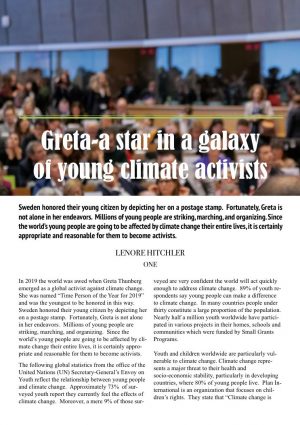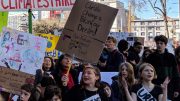 In 2019 the world was awed when Greta Thunberg emerged as a global activist against climate change. She was named “Time Person of the Year for 2019” and was the youngest to be honored in this way. Sweden honored their young citizen by depicting her on a postage stamp. Fortunately, Greta is not alone in her endeavors. Millions of young people are striking, marching, and organizing. Since the world’s young people are going to be affected by climate change their entire lives, it is certainly appropriate and reasonable for them to become activists.
In 2019 the world was awed when Greta Thunberg emerged as a global activist against climate change. She was named “Time Person of the Year for 2019” and was the youngest to be honored in this way. Sweden honored their young citizen by depicting her on a postage stamp. Fortunately, Greta is not alone in her endeavors. Millions of young people are striking, marching, and organizing. Since the world’s young people are going to be affected by climate change their entire lives, it is certainly appropriate and reasonable for them to become activists.
The following global statistics from the office of the United Nations (UN) Secretary-General’s Envoy on Youth reflect the relationship between young people and climate change. Approximately 73% of surveyed youth report they currently feel the effects of climate change. Moreover, a mere 9% of those surveyed are very confident the world will act quickly enough to address climate change. 89% of youth respondents say young people can make a difference to climate change. In many countries people under thirty constitute a large proportion of the population. Nearly half a million youth worldwide have participated in various projects in their homes, schools and communities which were funded by Small Grants Programs.
Youth and children worldwide are particularly vulnerable to climate change. Climate change represents a major threat to their health and socio-economic stability, particularly in developing countries, where 80% of young people live. Plan International is an organization that focuses on children’s rights. They state that “Climate change is recognised as the greatest threat to global health in the 21st century and can increase vector and water borne diseases, malnutrition, mental illnesses, respiratory diseases and injuries.”
A variety of statistics reveals the sizable scope of the ways in which climate change harms the young. According to the World Health Organization, children under the age of five suffer more than 80% of illnesses and mortality resulting from climate change.
The 2019 Lancet Countdown Study on Health and Climate Change reported “A child born today will experience a world that is more than four degrees warmer than the pre-industrial average.” To put this into perspective, the Little Ice Age from 1305-1850 saw worldwide temperatures drop by approximately two degrees centigrade. This resulted in crop failures, famines, and massive social disruption. Witchcraft trials, the Plague, and increased warfare have also been linked to the Little Ice Age.
Besides disrupting social relations and damaging health in general, natural disasters particularly affect the young in many ways. A report produced by Save the Children UK states that 50% of those killed by natural disasters are children. The Society for Research in Child Development published an article titled “Understanding the Impacts of Natural Disasters on Children.” The authors state that approximately 85% of billion-dollar disasters from 1980 to 2019 were linked to climate change and globally affected 175 million children. Some consequences for children include somatic symptoms such as headaches and nausea. Physical and mental health also deteriorates. Trauma can also alter brain anatomy and function which can lead to learning and memory difficulties. Fifty percent of children experience post-traumatic stress symptoms after natural disasters.
Girls are particularly vulnerable to natural disasters. The organization Plan International is especially concerned with conditions affecting girls. They report that “Evidence shows that adolescent girls face further protection issues after disasters and when migrating as they are particularly susceptible to violence and exploitation—including rape, sexual and gender-based violence and abuse, and trafficking. These protection issues are particularly heightened when collecting natural resources” [such as water and firewood.]
Despite all the reasons that justify youth activism in climate change, these young people face many criticisms. Critics state that they are manipulated by adults and claim they haven’t accomplished very much. Their adversaries also maintain that students use climate strikes as an opportunity to skip school. They also call activist’s fears hysterical, and charge that their demands are too extreme.
These young crusaders face many additional obstacles. They do not control any branches of government, do not enact laws nor do they enforce them. They do not control businesses or large financial institutions, bureaucracies, or major news outlets. In other words, they have no official power. They also have to contend with patronizing attitudes, stereotypes of being immature and irresponsible, invalidation, mockery, and even hatred. They also face a lack of trust in their ability, systemic silencing, and they lack funding and other resources.
In spite of these many liabilities, younger climate change activists have many assets to bring to the movement, including their high population numbers. The Statista Research Department reports that 26% of the global population is under fifteen. According to the UN, in 2019 youth worldwide numbered 1.2 billion persons between the ages of 15-24, or around 1 in every 6 persons. Young people are thus an outstanding and logical group to mobilize against climate change. Furthermore, most are already convinced that it is an important issue. A Gallup poll in 2018 found that 70% of those aged 18 to 34 report worrying about global warming compared to only 56% of those aged 55 or older. A 2019 Washington Post-Kaiser survey found that four out of five youth aged 13 to 17 called climate change a crisis or a major problem. Forty percent of high school students state that they have taken steps to reduce their carbon footprint, and one in four said they had participated in direct action.
Youthful activists frequently display incredible creativity. For example, the organization “Do Something” creates new methods to reach people. They suggest putting book markers into books showing how climate change affects those book’s settings. Another suggestion is to put pro-environmental scriptures in books at places of worship.
Many young climate activists work with other social causes, especially the Black Lives Matter movement. The organization “One Million Of Us” was started to promote voting and to unite youth social movements. Their goals are to fighting gun violence, immigration reform, both gender and racial equality, and climate change. Greta Thunberg is concerned with climate justice and stated that “There can be no social justice without climate justice. And there can be no climate justice unless we acknowledge the fact that we have dumped large parts of our emissions overseas, exploiting heap labour and poor working conditions as well as weaker environmental regulations.”
One advantage for youthful climate activists is that they possess moral authority. UN Secretary General Antonio Guterres has endorsed school strikes, saying: “My generation has failed to respond properly to the dramatic challenge of climate change. This is deeply felt by young people. No wonder they are angry.”
Youth activists are working with influential allies including the Dalai Lama. They are engaged worldwide in lawsuits in various court cases against several governments maintaining that they are not adequately fighting climate change. Large numbers of youth worldwide have taken a stand against climate change.
The March 15, 2019 strike took place in 125 countries and involved an estimated 1.6 million kids. On May 24, 2019, activists took part in more than 1,600 cities in 150 countries during the Global Climate Strike. The organization 350 reported that 7.6 million took part in climate strike actions the week of September 20-27, 2019.
There are many national youth organizations in the United States working against climate change. These organizations stress solidarity with all groups that have faced discrimination, especially those facing disproportionate damage from climate change. The Sunrise Movement works against climate change and promotes the Green New Deal.
Zero Hour is a climate justice organization especially concerned with how marginalized peoples, such as the indigenous, African American, Latinx, and LGBT (lesbian, gay, bisexual, and transgender) groups face more challenges from climate change than white middle-class America. There are local organizations concerned with climate justice found throughout the US.
Uplift is located in the region of the Colorado Plateau and the Southwest, and Treeage works in New York City. Defend Our Future was started by the Environmental Defense Fund and works for climate change and clean energy solutions. It is a good sign for the future of the environment that there are way too many organizations to include them all.
Besides organizations specifically devoted to climate change, many traditional organizations now include climate change in their work. In various states, girl scouts can earn climate change patches. 4H clubs also work against climate change. There are many youth organizations found throughout the rest of the world.
Earth Uprising is a youth organization committed to global action on climate change and one of their principles is that equity is the core of all climate change solutions. Climate Cardinals are found in over 40 countries. Some examples from developed countries are Youth 4 Climate, 350, and CliMates. One Up Action emphasizes climate justice with a focus on gender, racial, and class inequalities. The International Youth Climate Movement is a network of youth organizations.
Generation Climate Europe is a coalition representing over 460 organizations and represents over 20 million young Europeans. Youth and Environment Europe unites 52 member organizations from 30 countries. The Australian Youth Climate Coalition represents over 200,000. Generation Zero is a youth-led climate action organization in New Zealand.
There are many organizations throughout the developing world dedicated to fighting climate change. Africa is served by the African Youth Initiative on Climate Change. The Sudan Youth Organization on Climate Change and Youth and Environment is just one of many youth climate organizations in Africa. There are also youth organizations in the Caribbean, Central and South America, and Asia.
Several books on fighting climate change were written by young activists. Xiuhtezcatl Martinez’s book We Rise—The Earth Guardians Guide to Building a Movement That Restores the Planet was published when he was only seventeen. He organizes against climate change and is one of the leaders of Earth Guardians. It is an organization that strives to create a better world, including dealing with environmental problems such as climate change. Martinez suggested various methods of communicating about climate change, such as art and especially music.
His touched on many topics including pipelines, tar sands, fracking, agriculture, and the effects of climate change on oceans. He interviewed various people including international experts such as Vandana Shiva and Bill McKibben. McKibben used an eloquent metaphor when he stated, “the earth is running a fever, and the only antibodies available to fight that fever are us.”
This book is an excellent overview on the causes of climate change and how to fight it. Martinez’s book shows why climate change should be fought and Jamie Margolin’s book provides an excellent primer on exactly how to do so. Youth to Power—Your Voice and How to Use It was published when she was just nineteen years old. Besides providing thorough methods to organize and publicize social movements, she also interviewed many activists.
Our House is on Fire—Scenes of a Family and a Planet in Crisis was written by Greta Thunberg, her parents, and sister. The title is a perfect summary of the book since it fluctuates between climate change and family dilemmas and it is extremely eloquent. It is heart-wrenching when dealing with the neurological-based struggles of Greta and her sister. This book provides insights into Greta’s struggle to deal with her distress over climate change and how she was able to start her strike for climate change.
No One is Too Small to Make a Difference is a collection of Greta Thunberg’s speeches. Her speeches are very authoritative as climate scientists fact check them. The book includes her speech at the World Economic Forum presented just after her sixteenth birthday and includes this powerful exhortation:
I don’t want you to be hopeful.
I want you to panic.
I want you to feel the fear I feel every day.
And then I want you to act.
I want you to act as you would in a crisis
I want you to act as if our house is on fire.
Because it is.
This book also contained her stirring speech at the UN General Assembly which included:
This is all wrong. I shouldn’t be standing here, I should be back in school on the other side of the ocean. Yet you all come to us young people for hope? How dare you! You have taken away my dreams and my childhood with your empty words. And yet I’m one of the lucky ones. People are suffering. People are dying. Entire ecosystems are collapsing. We are in the beginning of a mass extinction. And all you can talk about is money and fairy tales of eternal economic growth. How dare you!
Very few adults are as articulate as she was at sixteen. There is no question why she is a worldwide icon and hero in the fight to preserve our planet. Greta represents just the tip of the iceberg of youthful activists attempting to steer us away from the ravages of climate change. They bring both knowledge and passion to the struggle, and their stories are inspiring for all of us.
Lenore Hitchler





